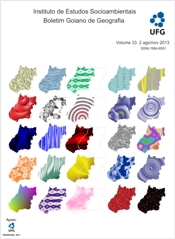WATER INFILTRATION AND POTENTIAL USE IN VERY SANDY SOILS (QUARTZIPSAMMENT) OF BRAZILIAN CERRADOS (SAVANNAS) - DOI 10.5216/bgg.v33i2.25556
DOI:
https://doi.org/10.5216/bgg.v33i2.25556Abstract
This paper presents an analysis on the potential use of Quartzipsamment soils of Brazilian cerrado (savannas) based on data from water infiltration rates in soils – field tests – and on physical, chemical, and morphological characteristics of samples collected in areas of Southwest, Goiás state. The climate is characterized by rainfall in the months from October to April and drought in the others. The most commonannual rainfall records, from 1600 to 1700 mm, are concentrated in the summer. In a few months reaches more than 400 mm, with rainfall of high intensity. The observations and analyzes indicated, in over 15% of the Southwest Goiás area, soils with more than 90% of sand, very poor in nutrients and available water capacity (AWC), around 35.7 mm to 1m deep, meaning – coupled with the frequent occurrence of periods over ten consecutive days without rain – high risk of crop frustration. The water infiltration rates in Quartzipsamment soils are very high and have excessive drainage. Due to being very friable soils, with little or no aggregation and low organic matter content, the high rain intensity indicates high erosion risks even at low slopes. Thus, we emphasize the need for research and actions to minimize damages to the ecosystems on RQo.
Downloads
Downloads
Published
How to Cite
Issue
Section
License
Authors will not receive any payment for publishing their work in Boletim Goiano de Geografia. Therefore, they must grant all rights to the journal. However, they are entirely and exclusively responsible for the published contents, and editors are free to make corrections or adjustments to texts in conformity with publication guidelines.







